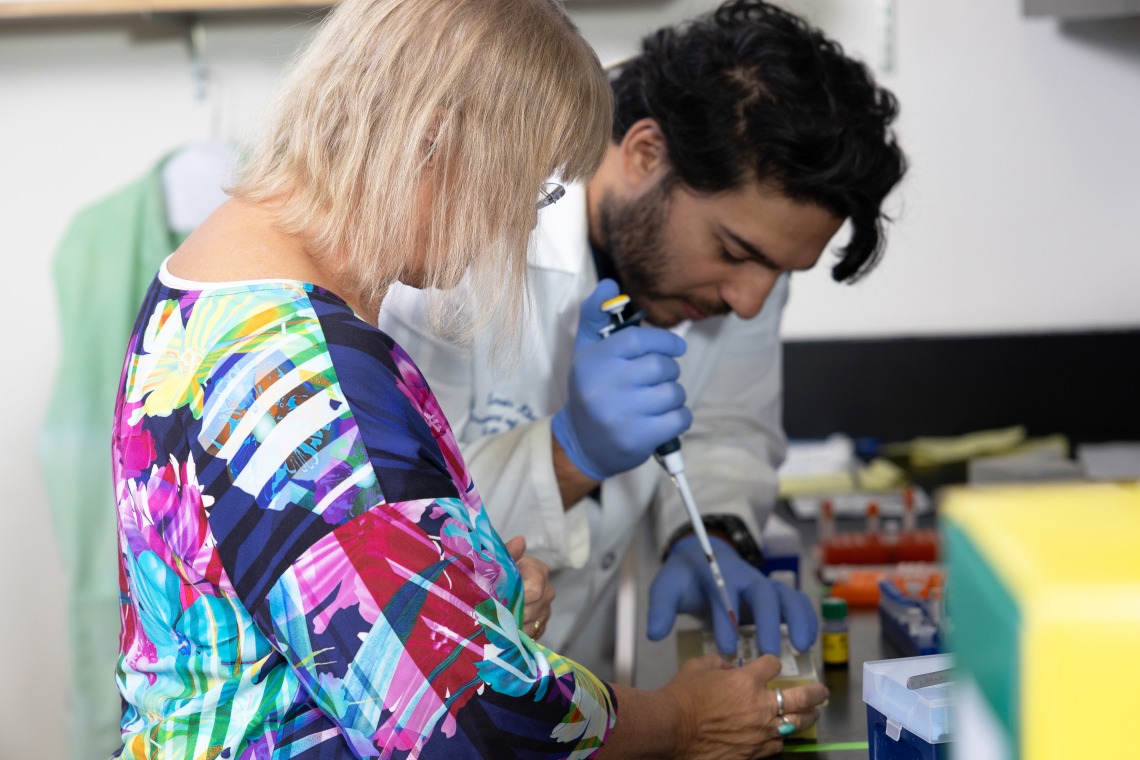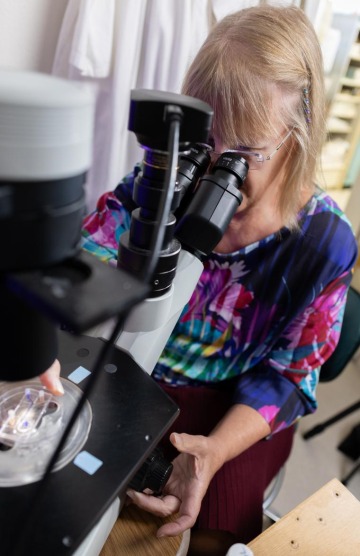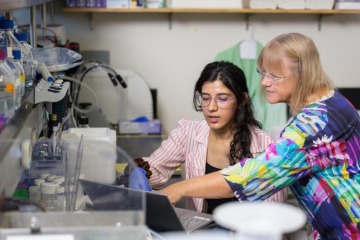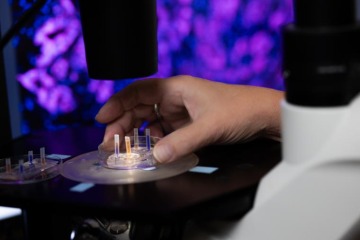Using human in vitro models to study prostate cancer
Dr. Cynthia Miranti successfully develops Prostate-on-a-Chip

Dr. Cindy Miranti works with a member of her team on a cell culture for one of their projects.
What if you could use human cells in their own microenvironment to discover how prostate cancer begins, metastasizes to bone, and develops drug resistance?
Dr. Cynthia Miranti, PhD, and her team are doing just that by developing the first successful Prostate-on-a-Chip model that recreates the development and differentiation processes that occur in a normal human prostate gland.
“We are using bioengineering approaches to develop human in vitro models that better represent human prostate cancer as it is seen in the clinic,” said Miranti, a professor in cellular and molecular medicine and the BIO5 Institute, and chair of the Cancer Biology Graduate Interdisciplinary Program.

The team uses this healthy prostate model to study how communications from a mutated cancer gene, called an oncogene, that has affected the thin tissue forming the outer layer of a body's surface and lining called the epithelium, influence androgen signaling in the underlying connective support framework, or stroma, and how impairment of that stromal signaling increases prostate cancer progression.
“We are also using this model to define the underlying genetic and epigenetic events that are dysregulated during prostate cancer development,” Dr. Miranti said. “Our long-term goal is to use these models to define new biomarkers that can help prostate cancer patients make better decisions about treatment.”
Developing Cancer-on-a-Chip
Dr. Miranti said that the discovery of Prostate-on-a-Chip was a multistep process that evolved over time. After researching the organ on a chip technology, Dr. Miranti saw that developing the game-changing innovation for the prostate would revolutionize her work.
“Early on, I was very interested in establishing human models,” Dr. Miranti said. “The potential is to answer the one penultimate question I always want to ask, ‘How did this tumor arise?’”
A physician-clinician and researcher she knew who was also working on cancer offered her some primary basal-epithelial cells from prostate patients that she had cultured.
“She and I set up this beautiful collaboration,” Dr. Miranti said. “I ultimately wanted to add oncogenes to the cultures to see how many oncogenes do we have to add to get cancer with a human model and what are those combinations? It really started me down as a road of really defining how prostate cancer develops.”

After struggling with creating the right culture model for the Prostate-on-a-Chip, Dr. Miranti attended a lecture featuring Cancer Center member Yitshak Zohar, PhD, a professor in the UArizona Department of Aerospace and Mechanical Engineering, who develops microfluidic systems for applications in life and health sciences. Together, they collaborated on a solution.
“That really introduced me to the concept of bioengineering in a more personal way,” she said. “I saw that when you have a problem, you can go to an engineer, and they can help you solve it.”
She said that a multidisciplinary approach to research, combined with working with clinicians in translational research, is essential in research discovery. Since coming to the University of Arizona, Dr. Miranti has established a multidisciplinary team approach to science that includes more than bioengineers. She also works with clinicians to know what is feasible and with drug developers to understand drug compounds.
“I think it is crucial to have that multiteam approach,” she said.
Examining bone metastasis
Now, Dr. Miranti is using the Prostate-on-a-Chip technology to understand the evolution of prostate cancer metastasizing to bone. She is attempting to connect bone tissue to a prostate chip with cancer to see how cells move to the metastatic stage.
“We can have a model where we have that cancer event happening, or we can put a patient sample in there and see if it has a bone tropism, which is a capacity to spread,” she said. “With that information, we can predict whether the patient might develop bone cancer in the future.”

Dr. Miranti said that she and her team have found that the Prostate-on-a-Chip technology to examine the bone tumor microenvironment and to test how it creates drug resistance. They hope to use this technology to identify biomarkers by circulating tumor cells and DNA to perform diagnostics that would assist in the investigation.
“Ultimately, it will allow for more personalized medicine,” she said. “Eventually, you will take a patient sample, put it in the chip and then ask specific questions about it. Drug resistant patients will be able to connect their tumors in this bone chip because that's the bone environment that their tumor is seeing, and we can ask whether the drugs are going to work in that bone environment.”

